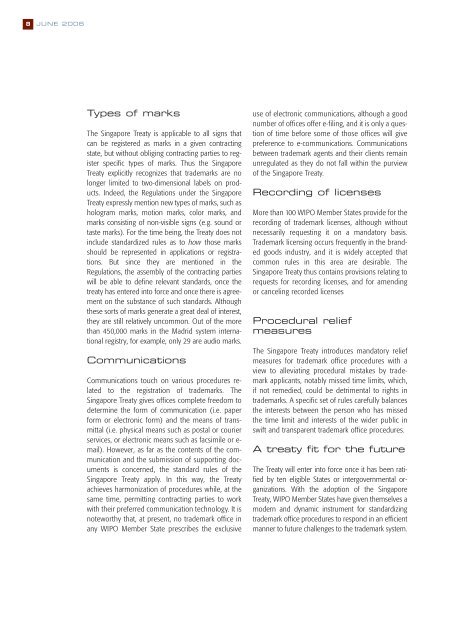the spirit of invention copyright in court world ip day round-up - WIPO
the spirit of invention copyright in court world ip day round-up - WIPO
the spirit of invention copyright in court world ip day round-up - WIPO
Create successful ePaper yourself
Turn your PDF publications into a flip-book with our unique Google optimized e-Paper software.
8<br />
JUNE 2006<br />
Types <strong>of</strong> marks<br />
The S<strong>in</strong>gapore Treaty is applicable to all signs that<br />
can be registered as marks <strong>in</strong> a given contract<strong>in</strong>g<br />
state, but without oblig<strong>in</strong>g contract<strong>in</strong>g parties to register<br />
specific types <strong>of</strong> marks. Thus <strong>the</strong> S<strong>in</strong>gapore<br />
Treaty explicitly recognizes that trademarks are no<br />
longer limited to two-dimensional labels on products.<br />
Indeed, <strong>the</strong> Regulations under <strong>the</strong> S<strong>in</strong>gapore<br />
Treaty expressly mention new types <strong>of</strong> marks, such as<br />
hologram marks, motion marks, color marks, and<br />
marks consist<strong>in</strong>g <strong>of</strong> non-visible signs (e.g. sound or<br />
taste marks). For <strong>the</strong> time be<strong>in</strong>g, <strong>the</strong> Treaty does not<br />
<strong>in</strong>clude standardized rules as to how those marks<br />
should be represented <strong>in</strong> applications or registrations.<br />
But s<strong>in</strong>ce <strong>the</strong>y are mentioned <strong>in</strong> <strong>the</strong><br />
Regulations, <strong>the</strong> assembly <strong>of</strong> <strong>the</strong> contract<strong>in</strong>g parties<br />
will be able to def<strong>in</strong>e relevant standards, once <strong>the</strong><br />
treaty has entered <strong>in</strong>to force and once <strong>the</strong>re is agreement<br />
on <strong>the</strong> substance <strong>of</strong> such standards. Although<br />
<strong>the</strong>se sorts <strong>of</strong> marks generate a great deal <strong>of</strong> <strong>in</strong>terest,<br />
<strong>the</strong>y are still relatively uncommon. Out <strong>of</strong> <strong>the</strong> more<br />
than 450,000 marks <strong>in</strong> <strong>the</strong> Madrid system <strong>in</strong>ternational<br />
registry, for example, only 29 are audio marks.<br />
Communications<br />
Communications touch on various procedures related<br />
to <strong>the</strong> registration <strong>of</strong> trademarks. The<br />
S<strong>in</strong>gapore Treaty gives <strong>of</strong>fices complete freedom to<br />
determ<strong>in</strong>e <strong>the</strong> form <strong>of</strong> communication (i.e. paper<br />
form or electronic form) and <strong>the</strong> means <strong>of</strong> transmittal<br />
(i.e. physical means such as postal or courier<br />
services, or electronic means such as facsimile or e-<br />
mail). However, as far as <strong>the</strong> contents <strong>of</strong> <strong>the</strong> communication<br />
and <strong>the</strong> submission <strong>of</strong> s<strong>up</strong>port<strong>in</strong>g documents<br />
is concerned, <strong>the</strong> standard rules <strong>of</strong> <strong>the</strong><br />
S<strong>in</strong>gapore Treaty apply. In this way, <strong>the</strong> Treaty<br />
achieves harmonization <strong>of</strong> procedures while, at <strong>the</strong><br />
same time, permitt<strong>in</strong>g contract<strong>in</strong>g parties to work<br />
with <strong>the</strong>ir preferred communication technology. It is<br />
noteworthy that, at present, no trademark <strong>of</strong>fice <strong>in</strong><br />
any <strong>WIPO</strong> Member State prescribes <strong>the</strong> exclusive<br />
use <strong>of</strong> electronic communications, although a good<br />
number <strong>of</strong> <strong>of</strong>fices <strong>of</strong>fer e-fil<strong>in</strong>g, and it is only a question<br />
<strong>of</strong> time before some <strong>of</strong> those <strong>of</strong>fices will give<br />
preference to e-communications. Communications<br />
between trademark agents and <strong>the</strong>ir clients rema<strong>in</strong><br />
unregulated as <strong>the</strong>y do not fall with<strong>in</strong> <strong>the</strong> purview<br />
<strong>of</strong> <strong>the</strong> S<strong>in</strong>gapore Treaty.<br />
Record<strong>in</strong>g <strong>of</strong> licenses<br />
More than 100 <strong>WIPO</strong> Member States provide for <strong>the</strong><br />
record<strong>in</strong>g <strong>of</strong> trademark licenses, although without<br />
necessarily request<strong>in</strong>g it on a mandatory basis.<br />
Trademark licens<strong>in</strong>g occurs frequently <strong>in</strong> <strong>the</strong> branded<br />
goods <strong>in</strong>dustry, and it is widely accepted that<br />
common rules <strong>in</strong> this area are desirable. The<br />
S<strong>in</strong>gapore Treaty thus conta<strong>in</strong>s provisions relat<strong>in</strong>g to<br />
requests for record<strong>in</strong>g licenses, and for amend<strong>in</strong>g<br />
or cancel<strong>in</strong>g recorded licenses<br />
Procedural relief<br />
measures<br />
The S<strong>in</strong>gapore Treaty <strong>in</strong>troduces mandatory relief<br />
measures for trademark <strong>of</strong>fice procedures with a<br />
view to alleviat<strong>in</strong>g procedural mistakes by trademark<br />
applicants, notably missed time limits, which,<br />
if not remedied, could be detrimental to rights <strong>in</strong><br />
trademarks. A specific set <strong>of</strong> rules carefully balances<br />
<strong>the</strong> <strong>in</strong>terests between <strong>the</strong> person who has missed<br />
<strong>the</strong> time limit and <strong>in</strong>terests <strong>of</strong> <strong>the</strong> wider public <strong>in</strong><br />
swift and transparent trademark <strong>of</strong>fice procedures.<br />
A treaty fit for <strong>the</strong> future<br />
The Treaty will enter <strong>in</strong>to force once it has been ratified<br />
by ten eligible States or <strong>in</strong>tergovernmental organizations.<br />
With <strong>the</strong> adoption <strong>of</strong> <strong>the</strong> S<strong>in</strong>gapore<br />
Treaty, <strong>WIPO</strong> Member States have given <strong>the</strong>mselves a<br />
modern and dynamic <strong>in</strong>strument for standardiz<strong>in</strong>g<br />
trademark <strong>of</strong>fice procedures to respond <strong>in</strong> an efficient<br />
manner to future challenges to <strong>the</strong> trademark system.

















